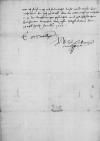Es seinn mir abermols briffe ann E(wer) G(naden) vonn meÿnne(m) gutten brwder, dem hernn ⌊Nÿbschicz⌋, an E(wer) G(naden) zcwkomen, / welche ich hiemit E(wer) G(naden) zcwschicke, / aus welchenn E(wer) G(naden) wirt vorstehenn, wie der friede allenthalbenn mit dem ⌊Turcken⌋ gemacht. / Es ⌊⌋ mir aber vonn ⌊Wienn⌋ aus ⌊Osterreich⌋, dat(um) XXVIII(!) instead of XXVII⌈XXVIII(!)XXVIII(!) instead of XXVII⌉ Marcÿ, / meÿnn gut freundt her ⌊Cornelius Scepperus⌋, ⌊kaÿ(serliche)r m(aieste)t⌋ inn ⌊Hungernn⌋ co(m)missari(us) unnd orator, / das der frid nicht so gemacht seÿ, wie des woÿwod(en) parteÿ vonn sich gibt, / sunder, / das so nu der ⌊Turcke⌋ czwir inn Hungernn gewest / unnd nicht sunders ausgericht, / so dar vonn geczogenn / unnd domit beÿ denn seinen / nicht wenigk seiner achtung vorlorenn, / das er nicht allein zcum frid geneigt, / sunder auch begert habe / unnd ⌊ro(misch)e ko(niglich)e m(aieste)t⌋ nicht ein fuszbreidt lands, / auch kein pfennigk tributs, das konigkreich zcw Hungernn zcw besiczenn, / im hab abgetrettenn oder noch gegebenn. / Schreibt mir auch, das, / wÿe sein altenn, vortrautenn freundt, / domit ich sein gloe superinscribed⌈ee superinscribed⌉ben(n) gebenn sol, / d written over ...⌈... illegible⌈...... illegible⌉dd written over ...⌉as concilium sol im jor mit der stelle benu(m)pt werdenn / unnd II jor dornoch gehaltenn, / it(e)m, das vom ⌊konige vonn Franckreich⌋ nichts seÿ zcwbesorgen. / ⌊Kaÿ(serlich)e m(aieste)t⌋ hab inn ⌊Italienn⌋ VII-M deutscher alter knecht / unnd sovil spaniger / unnd bisz inn die VIII-M schwere und geringe pferde, / unnd das kaÿ(serlich)e m(aieste)t denn XIIII dis monadts vonn ⌊Genua⌋ sol inn ⌊Hispanienn⌋ uberfarenn. / Sunst ist beÿ mir nichts newes, das E(wer) G(naden) nicht vor geschriebenn.  GStA, PK, HBA, C 2, No 38, f. 1v Wor ich sunst E(wer) G(naden) vil fruntlichs dinsts werde wissen zcwerczeigenn, bin ich wÿlligk. / Gott der allemechtige enthalde E(wer) G(naden) inn langkweriger gesuntheit / unnd gelugkseligem zcunhemenn lang czeit. /
GStA, PK, HBA, C 2, No 38, f. 1v Wor ich sunst E(wer) G(naden) vil fruntlichs dinsts werde wissen zcwerczeigenn, bin ich wÿlligk. / Gott der allemechtige enthalde E(wer) G(naden) inn langkweriger gesuntheit / unnd gelugkseligem zcunhemenn lang czeit. /
 GStA, PK, HBA, C 2, No 38, f. 2v
GStA, PK, HBA, C 2, No 38, f. 2v  GStA, PK, HBA, C 2, No 38, f. 1r
GStA, PK, HBA, C 2, No 38, f. 1r  GStA, PK, HBA, C 2, No 38, f. 1v Wor ich sunst E(wer) G(naden) vil fruntlichs dinsts werde wissen zcwerczeigenn, bin ich wÿlligk. / Gott der allemechtige enthalde E(wer) G(naden) inn langkweriger gesuntheit / unnd gelugkseligem zcunhemenn lang czeit. /
GStA, PK, HBA, C 2, No 38, f. 1v Wor ich sunst E(wer) G(naden) vil fruntlichs dinsts werde wissen zcwerczeigenn, bin ich wÿlligk. / Gott der allemechtige enthalde E(wer) G(naden) inn langkweriger gesuntheit / unnd gelugkseligem zcunhemenn lang czeit. /


